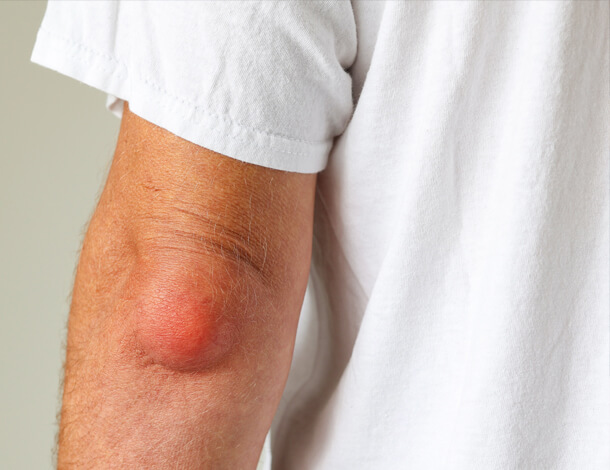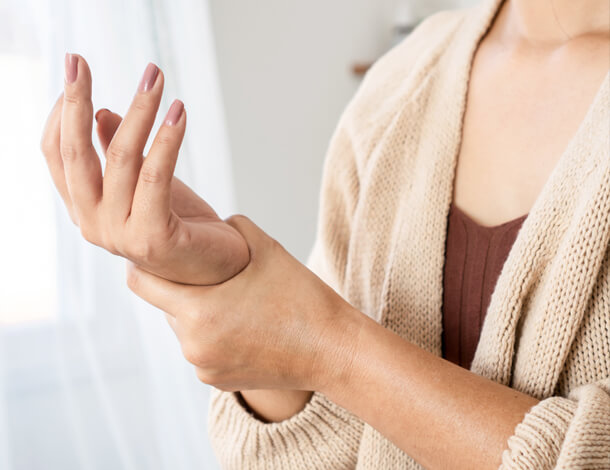Ouch! Could Elbow Bursitis Be the Cause of Your Elbow Pain and Swelling?

Whether you’re on the job or taking swings on the pickleball court, elbow injuries can happen to anyone—and sometimes result in a case of elbow bursitis. Fortunately, this condition is treatable and usually goes away with a few weeks of proper rest and care.
In this article, we will examine the typical causes and symptoms of elbow bursitis and the treatments that can heal your elbow and get you back to feeling your best.
What Is Elbow Bursitis?
Elbow bursitis (also called olecranon bursitis) is an inflammation of the bursa—a small fluid-filled sac that cushions and lubricates your elbow joint. This painful condition can be caused by repetitive motion, trauma, or infection.
The largest joints in your body are all surrounded by a bursa sac, which provides a cushion between your bones and the muscles, tendons, or skin they come up against. The elbow bursa lies between the bony tip of your elbow and your skin.
Normally, the elbow bursa only contains a small amount of fluid. But, it can fill up with extra fluid if it becomes irritated or damaged, causing pain and swelling. This is when elbow bursitis occurs.
Elbow Bursitis Causes
Elbow bursitis symptoms can come on suddenly or increase over time. One of the most common causes is trauma to the elbow, like from the impact of a fall on a hard surface. This type of injury is common in sports such as hockey, basketball, and volleyball.
Bursitis can also develop in people who repeatedly rest their elbows on a desk during work or school. This is sometimes referred to as “student’s elbow.” People who work certain manual labor jobs, such as plumbers, mechanics, and painters, are also more prone to developing bursitis because of the repetitive motions of their work.
In some cases, elbow bursitis can be caused by an infection. This can happen after an injury (like a cut, scrape, or bite) that breaks the skin at the tip of your elbow, allowing bacteria to get inside the bursa sac. The infected bursa produces excess fluid, resulting in swelling, pain, and redness.
Is Elbow Bursitis Contagious if An Infection Causes It?
Elbow bursitis itself isn’t contagious. However, if an infection causes it, the bacteria can spread through direct contact or shared objects. You can prevent the spread of infection with proper hygiene and wound care.
Is Bursitis a Form of Arthritis?
While elbow arthritis and bursitis have some symptoms in common—including pain, inflammation, and swelling—they are considered different elbow problems.
Osteoarthritis and rheumatoid arthritis of the elbow are chronic conditions. In contrast, bursitis is a temporary condition that can be caused by overuse, injury, or infection and will typically improve with rest or conservative treatments.
Elbow Bursitis Symptoms
While there are several different initial causes of bursitis, as mentioned above, the symptoms can be the same or similar in most cases. However, the severity of your symptoms may vary.
The most common symptoms of elbow bursitis include:
- Swelling or a soft lump around your elbow
- Pain (especially when moving your elbow)
- Redness or warmth (signs of an infection)
Can Elbow Bursitis Lead to Complications if Left Untreated?
Untreated bursitis, especially if an infection causes it, can lead to severe complications such as the spread of infection to other parts of the body. Joint limitation from chronic elbow bursitis is rare.
Diagnosing Elbow Bursitis
Diagnosis usually involves a physical examination and a detailed medical history. Additional diagnostic tests such as X-rays or MRIs can rule out other conditions. Sometimes, a fluid sample from the bursa may be examined to check for infection.
Who Is at Risk?
Anyone can develop elbow bursitis, but people with some types of jobs, hobbies, or certain medical conditions have a higher risk, including:
- People with jobs or hobbies that require a lot of time on hands and knees (e.g., carpenters, mechanics, electricians)
- Those who work at a desk or spend a lot of time leaning on their elbows
- Athletes who play sports that require repetitive motions with the elbows and arms (e.g., baseball, bowling, volleyball)
- Individuals with certain medical conditions, including rheumatoid arthritis, gout, diabetes, and thyroid disease
Take the elbow pain assessment
Elbow Bursitis Treatment
Because many different elbow conditions can cause pain and inflammation, seeing a specialist for a proper diagnosis is essential. Your elbow doctor will ask you about your symptoms and any injuries you may have experienced and physically examine your elbow.
To rule out other potential causes for your pain and to check for infection, your doctor may want to do a few tests, like an X-ray, MRI, or blood test. They may also take a small fluid sample from the bursa sac.
If there is no sign of infection, your doctor will likely recommend rest and at-home treatments, such as:
- Avoiding the activity that caused your bursitis (usually temporarily)
- A compression wrap or sleeve on your elbow
- Icing the elbow to decrease swelling (15–20 minutes, two or three times per day)
- Nonsteroidal Anti-Inflammatory Drugs (NSAIDs) to help with pain and inflammation
- A splint or brace to keep the elbow immobilized so it can heal properly
- An elbow pad or cushion to use at home or work
With these at-home treatments and modifications, elbow bursitis usually heals within three to six weeks. If swelling and pain persist, your doctor may use a needle to drain excess fluid from the bursa. Additionally, injecting the bursa with a corticosteroid may help reduce inflammation.
Care for Elbow Bursitis Caused by Infection
In the case of infection, the fluid will typically need to be drained and sent to a laboratory for analysis so your doctor can prescribe the right antibiotic to treat it. Elbow bursitis rarely requires surgery. Your bursa may need removal if the infection doesn’t improve with drainage and antibiotics. After an elbow surgeon removes your bursa, it usually grows back within a few months.
Nutrition Considerations:
Eating the right healthy foods isn’t a cure for elbow bursitis, but maintaining a diet rich in anti-inflammatory foods is one thing you can do to support total joint health. Therefore, your elbow specialist may recommend eating more foods high in omega-3 fatty acids, like fish and flaxseed.
Prevention Tips
Here are some ideas of steps you can take to prevent developing elbow bursitis.
Elbow Cushioning
Your first line of defense is to pay attention to your elbow’s position during daily activities. For instance, if your job or hobbies have you frequently leaning and putting weight on your elbows, it might be time for an elbow pad or cushion to limit the irritation of your bursa sac.
Workplace Ergonomics
Another preventive strategy is to focus on ergonomics, especially if you spend considerable time at a desk. Ensure that your setup encourages good posture and that your elbows are not bearing excessive weight or experiencing repetitive friction. Making simple adjustments, like raising or lowering the height of your chair or the position of your keyboard, can make a difference.
Safeguards When Exercising
Physical activity often plays a role in the onset of elbow bursitis. Consider doing regular strengthening and flexibility exercises—designed to enhance joint stability—if you’re an athlete or someone with a job or hobby that requires you to make repetitive elbow motions.
Similarly, warming up before physical activity and cooling down afterward can prepare the muscles and joints for the stress they will undergo, minimizing risk.
Wellness for Joint Health
Lastly, maintaining overall joint health through nutrition and hydration can be beneficial. A diet rich in anti-inflammatory foods—like leafy greens and berries—helps support your joints and potentially lowers your chances of developing conditions such as elbow bursitis.
More FAQs About Elbow Bursitis
When you’re feeling any sort of elbow pain, getting straightforward and clear information from a joint specialist is invaluable. That’s why we’ve compiled answers below to some of our patients’ most frequently asked questions about elbow bursitis that you might find useful.
What Is the Role of the Bursa in the Elbow?
Your bursa is a cushion between the tip of your elbow bone and the skin. It’s akin to a small fluid-filled pad that facilitates smooth and pain-free movement of your elbow joint.
Is Elbow Bursitis Age-Specific?
No, elbow bursitis can occur in individuals of all ages. However, it’s more prevalent in adults due to work-related activities or specific sports they may engage in.
What Makes Bursitis Different From Other Causes of Elbow Pain?
As mentioned above, symptoms of elbow bursitis typically include swelling and discomfort. However, to accurately diagnose the cause of your elbow pain and rule out other potential conditions, your elbow specialist may run diagnostic tests, including imaging or fluid analysis.
How Long Does It Take to Recover From Elbow Bursitis?
Most cases of elbow bursitis improve with appropriate home care within three to six weeks. For persistent or severe cases, an elbow specialist may recommend medical intervention (such as fluid drainage or corticosteroid injections).
Do You Have to Stop Exercising if You Have Elbow Bursitis?
You’ll want to temporarily refrain from activities that aggravate your elbow bursitis. Frequently, patients can return to regular activities after proper treatment and rest, but it’s always best to check with your doctor and what is right for you.
Choose the Right Elbow Specialist
Selecting the right specialist to diagnose and treat your elbow pain is crucial. When looking for a new provider, some key factors include board certification, a sub-specialty in elbow treatment, extensive experience, and a multi-disciplinary approach.
An excellent healthcare organization will offer cutting-edge diagnostic tools and minimally invasive treatment options to ensure efficient and effective care. Moreover, they should also have supportive staff and patient testimonials as evidence of their specialists’ high-quality service.
Why IHTSC Is Your Best Choice
When elbow pain keeps you from working, playing sports, or doing everyday activities, the experienced team at Indiana Hand to Shoulder Center can help you get the elbow pain relief you need.
Our board-certified elbow specialists have years of hands-on experience treating various elbow conditions, including bursitis, fractures, dislocations, arthritis, and more. Don’t let elbow pain hold you back any longer. Make IHTSC your first choice for all your elbow health needs.
You might also like:



